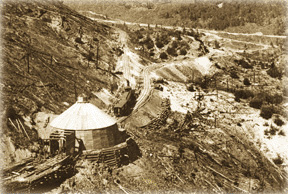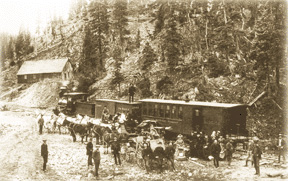| Silverton Magazine - Silverton, Colorado | ||
| Railroads | Burke's Custom Tours for Photographers & Artists | Silverton Magazine Home Page |
 |
|
©San Juan Publishing Group, Inc, All rights reserved.
AT THE NORTHERN END of the Durango & Silverton Narrow Gauge Railroad, in an ancient volcanic caldera, lies the town of Silverton. It was settled in the early 1870s by prospectors searching for gold. Legend has it that the town got its name when a miner commented, "My mine ain't got much gold, but there's silver by the ton."  Originally accessible only by mule trails (soon upgraded to wagon
roads), within 20 years of its founding, Silverton was served by four
separate railroads. The largest, the Denver and Rio Grande (now the
D&SNGRR) came up the Animas River canyon from Durango. Three
smaller railroads—all owned at various times by Otto Mears—also served
the nearby mines.
Originally accessible only by mule trails (soon upgraded to wagon
roads), within 20 years of its founding, Silverton was served by four
separate railroads. The largest, the Denver and Rio Grande (now the
D&SNGRR) came up the Animas River canyon from Durango. Three
smaller railroads—all owned at various times by Otto Mears—also served
the nearby mines.
The Silverton Railroad (Otto Mears' "Rainbow Route") was built in 1887 to connect Silverton with the mines to the north in the Red Mountain Mining District and Ouray County. The terrain was rugged—in some places, nearly inaccessible—and connected by rough trails and Otto Mears' toll roads. Mears decided to lay track along his toll road through the Red Mountain area. The grades were so steep and the curves so sharp—maximum curvature 30 degrees—the task was almost impossible. At the northern end of the route, a switchback traversed the five-percent grade to Corkscrew Gulch. After the first winter, a fifty-foot turntable enclosed by a snowshed was built there to turn locomotives. Because the grade was so steep, it was necessary, especially in snow, to have the locomotive at the front and running forward to prevent derailment or runaway trains. The line never did make it all the way to Ouray, although Mears did have a plan to continue the line via an electric cog railway—a vision that ended with the Silver Panic of 1893. The line was abandoned in 1922. Today the "Million Dollar Highway" (Highway 550) closely parallels, and in places overlaps, Mears' Rainbow Route  The Silverton Northern, built in 1896, followed the Animas River north
to the Silver Lake Mill, through Eureka to Animas Forks at 11,584 feet.
Not much is left of old Eureka, but thanks to the San Juan County
Historical Society, Animas Forks is a well-preserved "ghost town"
easily accessible by automobile today. The Silverton Northern, built in 1896, followed the Animas River north
to the Silver Lake Mill, through Eureka to Animas Forks at 11,584 feet.
Not much is left of old Eureka, but thanks to the San Juan County
Historical Society, Animas Forks is a well-preserved "ghost town"
easily accessible by automobile today.
The Silverton Gladstone and Northerly ran northwest along Cement Creek. Built in 1899 by the Gold King Mine in Gladstone, the line hauled out more than 300 tons of ore a day for forwarding to the smelter in Durango. Otto Mears leased the railroad in 1910, then purchased it five years later. It continued to operate until 1939 when the Gold King played out. Photographs Rainbow Route Corkscrew Turntable, circa 1890, © San Juan County Historical Society; Silverton Train in Red Mountain Town, Sept.17, 1888. Otto Mears is visible in this photo, standing near the right of the photo. The combination passenger/baggage car is in Silverton awaiting refurbishment, © San Juan County Historical Society. |
|
The Silverton Magazine. Copyright 2000-2010 Published by San Juan Publishing Group, Inc., Colorado No part of this publication may be reproduced in any means whatsoever without written authorization from SJPG. (plagerizers will be hung from the yardarm and fed to the mountain sharks!) Queries for re-print rights, email [email protected] |
Copyright San Juan Publishing Group, Inc. Web design by Kathryn R Burke